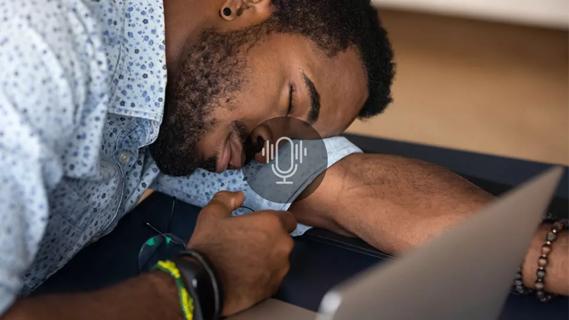Combining group telehealth sessions with one-on-one sessions shortens time to follow-up care

Cleveland Clinic’s Sleep Disorders Center began offering a hybrid model of cognitive behavioral therapy for insomnia (CBT-I) two years ago that has significantly improved access to care, according to a study presented at the recent SLEEP 2023 meeting.
Advertisement
Cleveland Clinic is a non-profit academic medical center. Advertising on our site helps support our mission. We do not endorse non-Cleveland Clinic products or services. Policy
In 2019, before initiation of the hybrid CBT-I model, the time between initial evaluation and a follow-up appointment was 31 days for Sleep Disorders Center patients diagnosed with insomnia. In 2021, under the hybrid CBT-I model, this time declined to 11 days (P < 0.001).
“One of the biggest challenges in all of sleep medicine is access to insomnia treatment,” says lead investigator Alicia Roth, PhD, a psychologist in the Sleep Disorders Center. “A big part of that is access to healthcare providers who know how to do CBT-I ― the gold standard for insomnia treatment ― and have the capacity to see patients regularly.”
Prior to implementation of the hybrid model, the typical course of treatment for patients with insomnia was an initial evaluation followed by several one-on-one sessions with a psychologist. Now patients attend a 60-minute group telehealth session after their evaluation that introduces sleep psychoeducation and stimulus control before patients begin one-on-one sessions.
“CBT-I is tailored to individual patients, but the first session usually covers the science of sleep no matter where the patient’s treatment will begin or what their comorbidities are,” Dr. Roth explains. “It’s crucial for all patients to understand how insomnia develops, so it seemed logical to provide this education in a group setting.”
Cleveland Clinic holds the telehealth sessions via Zoom once a week on different days and times. Dr. Roth and two other psychologists, Michelle Drerup, PsyD, and Alexa Kane, PsyD, take turns leading the class.
Advertisement
“It lays the groundwork for patients,” says Dr. Roth. “We started noticing that they are more prepared in the first one-on-one session to do the work because they understand the basic concepts.”
To quantify the model’s suspected benefits, Dr. Roth and her colleagues conducted a retrospective chart review. They investigated whether the hybrid intervention would provide greater access to CBT-I than the traditional CBT-I model. Patients receiving in-person, one-on-one CBT-I in 2019 (n = 200) were compared with patients receiving the hybrid telehealth/one-on-one session model in 2021.
In 2021, the three psychologists led 40 group telehealth follow-up sessions during time slots previously reserved for individual follow-up sessions. Of 418 patients scheduled for these group sessions, 341 attended (82% attendance rate). “The modal number of therapy sessions patients have is one, so to get such a high percentage of people to come to a follow-up session is significant,” says Dr. Roth.
Since 341 patients were seen in group sessions during time slots that would have been reserved for 40 one-on-one sessions, an additional 301 patients were seen for a first follow-up session as a result of the hybrid model’s introduction. Of the 341 patients seen in group sessions, 299 had adequate data for analysis and constituted the cohort for the 2021 hybrid CBT-I group.
In addition to reduced time to first follow-up session (11 vs. 31 days, as noted above) and robust attendance, the study revealed other benefits from introduction of the hybrid model. The rate of treatment completion (i.e., ≥ 3 sessions) was higher in 2021 than in 2019 (59% vs. 43%; P < 0.001), and patients attended significantly more total sessions (mean of 3.35 vs. 2.92, respectively; P = 0.027).
Advertisement
However, the wait time from initial evaluation to the first one-on-one appointment in 2021 was 38.8 days compared with 31.3 days in 2019. “The time to a one-on-one appointment got longer during the pandemic,” Dr. Roth observes. “But adding in the group session allowed patients to get going with treatment while they waited. We gave them some instructions on stimulus control, and they started sleep diaries.”
The hybrid CBT-I group was significantly older than the traditional CBT-I group, but multivariate linear regression analysis found age to not be a significant predictor of time to first follow-up or time from new evaluation to first one-on-one follow-up.
Drs. Roth, Drerup and Kane would like to conduct further studies of the hybrid CBT-I model, including investigating its impact on healthcare costs.
“We’d like to demonstrate whether CBT-I saves money — not only for patients, but also for healthcare systems, because patients who sleep better are generally healthier long-term,” says Dr. Roth.
The psychologists also would like to investigate differences in typical insomnia treatment outcomes with application of the CBT-I hybrid model, using patients’ self-reported data.
In addition to follow-up research, Dr. Roth and colleagues are making operational improvements. For instance, they are creating a digital sleep diary in the Epic electronic health record and MyChart®, Cleveland Clinic’s online health management platform, for streamlined access for providers and patients. They also hope to integrate the Care Companion app for at-home monitoring into Epic to facilitate communication between patients and providers between visits.
Advertisement
“The root of all of this is improving access to experts,” says Dr. Roth. “There are a limited number of experts trained in behavioral sleep medicine, and the CBT-I hybrid model provides access to a greater number of patients and gets the experts involved at the ground floor of care.”
Advertisement
Advertisement

Study highlights value of sleep disorder screening and targeted management strategies

Specificity in study criteria yields sleep disorder insights

Large cohort study suggests need for routine sleep screening as part of neurological care

Testing options and therapies are expanding for this poorly understood sleep disorder

Normal or inconsistent MSLT results should not rule out this debilitating disorder

Advice for diagnosing and managing sleep disturbances in children

Bedroom safety, medication use and ethical dilemmas are addressed

Studies of three investigational therapies test targeting of mechanistic pathways